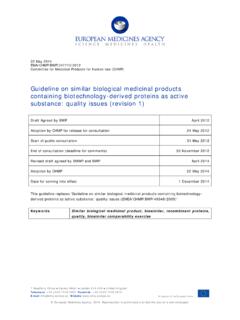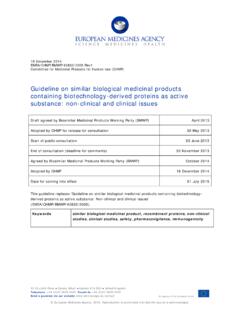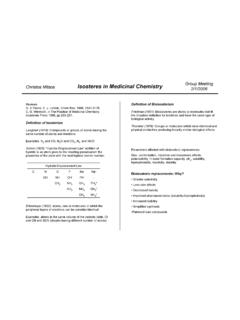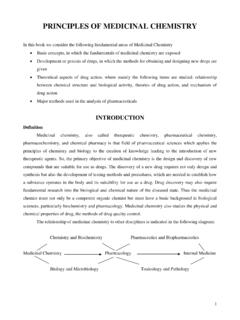Transcription of ANNEX I SUMMARY OF PRODUCT CHARACTERISTICS
1 1 ANNEX I SUMMARY OF PRODUCT CHARACTERISTICS 2 This medicinal PRODUCT is subject to additional monitoring. This will allow quick identification of new safety information. Healthcare professionals are asked to report any suspected adverse reactions. See section for how to report adverse reactions. 1. NAME OF THE medicinal PRODUCT Comirnaty c oncentrate for dispersion for injection COVID-19 mRNA Vaccine (nucleoside modified) 2. QUALITATIVE AND QUANTITATIVE COMPOSITION This is a multidose vial and must be diluted before use. One vial ( mL) contains 5 doses of mL after dilution. 1 dose ( mL) contains 30 micrograms of COVID-19 mRNA V accine (embedded in lipid nanoparticles).
2 Single-stranded, 5 -capped messenger RNA (mRNA) produced using a cell-free in vitro transcription from the corresponding DNA templates, encoding the viral spike (S) protein of SARS-CoV-2. For the full list of excipients, see section 3. PHARMACEUTICAL FORM Concentrate for dispersion for injection ( sterile concentrate). The vaccine is a white to off-white frozen dispersion ( pH: - ). 4. CLINICAL PARTICULARS Therapeutic indications Comirnaty is indicated for active immunisation to prevent COVID-19 caused by SARS-CoV-2 virus, in individuals 16 years of age and older. The use of this v accine should be in accordance with official recommendations.
3 Posology and method of administration Posology Individuals 16 years of age and older Comirnaty is administered intramuscularly after dilution as a course of 2 doses ( mL each) at least 21 days apart (see sections and ). There are no data available on the interchangeability of Comirnaty with other COVID-19 vaccines to complete the vaccination course. Individuals who have received 1 dose of Comirnaty should receive a second dose of Comirnaty to complete the vaccination course. Paediatric population The safety and efficacy of Comirnaty in children and adolescents aged less than 16 years of age have not yet been established. Limited data are available.
4 3 Elderly population No dosage adjustment is required in elderly individuals 65 years of age. Method of administration Comirnaty should be administered intramuscularly. The preferred site is the deltoid muscle of the upper arm. Do not inject the vaccine intravascularly, subcutaneously or intradermally. The vaccine should not be mixed in the same syringe with any other vaccines or medicinal products. For precautions to be taken before administering the vaccine, see section For instructions regarding thawing, handling and disposal of the vaccine, see section Contraindications Hypersensitivity to the active substance or to any of the excipients listed in section Special warnings and precautions for use Traceability In order to improve the traceability of biological medicinal products, the name and the batch number of the administered PRODUCT should be clearly recorded.
5 General recommendations Hypersensitivity and anaphylaxis Events of anaphylaxis have been reported. Appropriate medical treatment and supervision should always be readily available in case of an anaphylactic reaction following the administration of the vaccine. Close observation for at least 15 minutes is recommended following vaccination. A second dose of the vaccine should not be given to those who have experienced anaphylaxis to the first dose of Comirnaty. Anxiety-related reactions Anxiety-related reactions, including vasovagal reactions (syncope), hyperventilation or stress related reactions may occur in association with vaccination as a psychogenic response to the needle injection.
6 It is important that precautions are in place to avoid injury from fainting. Concurrent illness Vaccination should be postponed in individuals suffering from acute severe febrile illness or acute infection. The presence of a minor infection and/or low-grade fever should not delay vaccination. Thrombocytopenia and coagulation disorders As with other intramuscular injections, the vaccine should be given with caution in individuals receiving anticoagulant therapy or those with thrombocytopenia or any coagulation disorder (such as haemophilia) because bleeding or bruising may occur following an intramuscular administration in these individuals. 4 Immunocompromised individuals The efficacy, safety and immunogenicity of the vaccine has not been assessed in immunocompromised individuals, including those receiving immunosuppressant therapy.
7 The efficacy of Comirnaty may be lower in immunosuppressed individuals. Duration of protection The duration of protection afforded by the vaccine is unknown as it is still being determined by ongoing clinical trials. Limitations of vaccine effectiveness As with any vaccine, vaccination with Comirnaty may not protect all vaccine recipients. Individuals may not be fully protected until 7 days after their second dose of vaccine. Excipients: This vaccine contains less than 1 mmol potassium (39 mg) per dose, that is to say essentially potassium-free . This vaccine contains less than 1 mmol sodium (23 mg) per dose, that is to say essentially sodium-free.
8 Interaction with other medicinal products and other forms of interaction No interaction studies have been performed. Concomitant administration of Comirnaty with other vaccines has not been studied. Fertility, pregnancy and lactation Pregnancy There is limited experience with use of Comirnaty in pregnant women. Animal studies do not indicate direct or indirect harmful effects with respect to pregnancy, embryo/foetal development, parturition or post-natal development (see section ). Administration of Comirnaty in pregnancy should only be considered when the potential benefits outweigh any potential risks for the mother and foetus. Breast-feeding It is unknown whether Comirnaty is excreted in human milk.
9 Fertility Animal studies do not indicate direct or indirect harmful effects with respect to reproductive toxicity (see section ) Effects on ability to drive and use machines Comirnaty has no or negligible influence on the ability to drive and use machines. However, some of the effects mentioned under section may temporarily affect the ability to drive or use machines. 5 Undesirable effects SUMMARY of safety profile The safety of Comirnaty was evaluated in participants 16 years of age and older in 2 clinical studies that included 21,744 participants that have received at least one dose of Comirnaty. In Study 2, a total of 21,720 participants 16 years of age or older received at least 1 dose of Comirnaty and a total of 21,728 participants 16 years of age or older received placebo (including 138 and 145 adolescents 16 and 17 years of age in the vaccine and placebo groups, respectively).
10 A total of 20,519 participants 16 years of age or older received 2 doses of Comirnaty. At the time of the analysis of Study 2, a total of 19,067 (9,531 Comirnaty and 9,536 placebo) participants 16 years of age or older were evaluated for safety for at least 2 months after the second dose of Comirnaty. This included a total of 10,727 (5,350 Comirnaty and 5,377 placebo) participants 16 to 55 years of age and a total of 8,340 (4,181 Comirnaty and 4,159 placebo) participants 56 years and older. The most frequent adverse reactions in participants 16 years of age and older were injection site pain (> 80%), fatigue (> 60%), headache (> 50%), myalgia and chills (> 30%), arthralgia (> 20%), pyrexia and injection site swelling (> 10%) and were usually mild or moderate in intensity and resolved within a few days after vaccination.
















